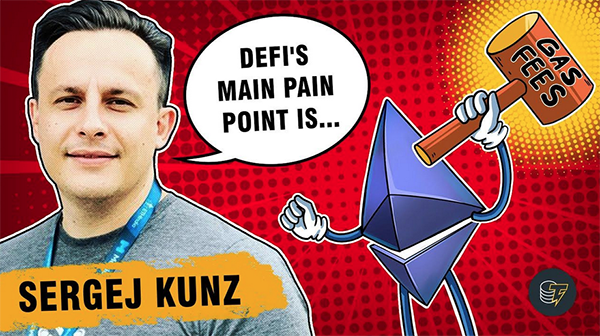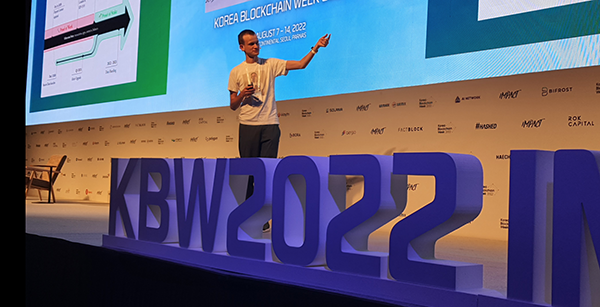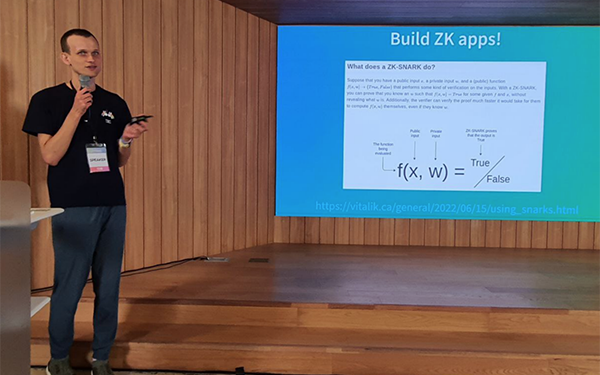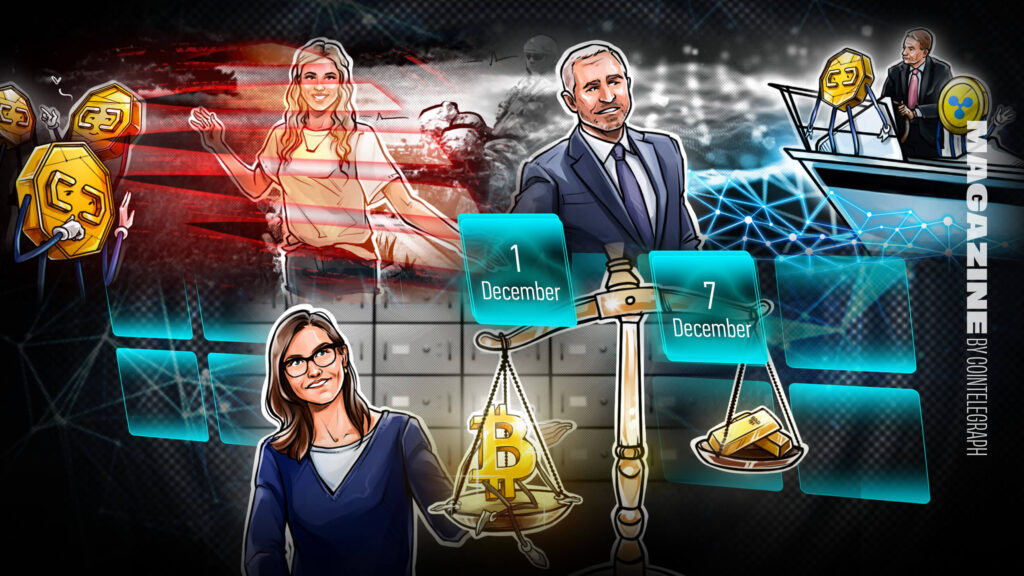There’s a version of the future that’s tantalizingly possible in which Ethereum becomes the base layer for pretty much everything.
Recent advances in a technology called zero-knowledge Rollups — from StarkWare, Polygon and zkSync — enable the blockchain to move from fewer than 20 transactions per second to… well, an infinite number of TPS.
In theory, it would allow the entire world’s financial system to run on Ethereum.
“I think it’s theoretically possible,” explains Declan Fox, product manager for rollups at Consensys, which provides Ethereum infrastructure and apps like MetaMask. “We have the technology to achieve that kind of throughput necessary.”
“With recursive rollups and proofs, we theoretically can infinitely scale.”
He adds it obviously hasn’t been proven in production yet, “so that’d be the next step.”
The tech is so new and so promising that soon after it became viable, Ethereum rearranged its entire roadmap to take advantage of it. This week’s Merge is arguably the least interesting bit of the coming changes.
One of the pioneers of zero-knowledge proofs — or validity proofs as he prefers to call them — is StarkWare co-founder Eli Ben-Sasson. He worked on the problem for two decades, helping nurture it from an abstract theoretical concept — “something that is completely galactic and impossible, not enough atoms in the solar system to record even one such proof” — down to something that can efficiently be generated on a laptop.
At its most basic, the process employs high-level mathematics to generate a tiny validity proof that verifies that a whole bunch of other transactions has been carried out correctly. Instead of putting all the transactions on the slow and creaky blockchain, you just record one proof in a transaction.
“This technology lets you send a very succinct proof that asserts that a computation was done correctly — even when you weren’t watching, which I think is the most magical aspect,” he explains.
“What validity proofs deliver, they deliver integrity; they let me know that the right thing was done by others — that someone processed 10,000 transactions, even when I wasn’t watching, and they didn’t steal my money. That’s what they deliver.”
Tens of thousands of transactions being compressed into a single transaction on Ethereum is impressive enough, but the magic doesn’t stop there.
Validity proofs work a little bit like fractals — the closer you look, the further into the distance they stretch. You can take 10 validity proofs — each representing 10,000 transactions — and generate an entirely new validity proof verifying that those other 10 proofs are correct.
Suddenly you have 100,000 transactions rolled up into one. This is called a “recursive proof,” and you can just keep doing it over and over again.
“It is a proof of proving. And so, you can further compound the savings because each time you generate a proof, you’ve compressed the process of verifying computation. So, basically, you can compress again and again.”

Our interview is held the same week that StarkWare puts recursive proofs into production. The zkSync project, which uses the slightly different zkSNARKS instead of zkSTARKS starks, has implemented its own version of recursive proofs.
StarkWare has already rolled up as many as 600,000 NFT mints into a single transaction on ImmutableX, and Ben-Sasson says they’ll be able to cram 6 million NFTs into a single transaction soon and then “60 million with more engineering and tweaking.”
While there are still some problems to overcome, this type of scaling capability puts crypto back in the game for everyday payments and microtransactions — such as paying a few cents to read a paywalled article rather than being forced to take out a monthly subscription. Long hampered by high fees and 10-minute wait times for payments to go through, crypto finally has the opportunity to fulfill Satoshi Nakamoto’s original vision of becoming peer-to-peer cash.
Ethereum co-founder Vitalik Buterin told attendees at last month’s Korea Blockchain Week that scaling meant payments were back on the table:
“It’s a vision that has been, I think, forgotten a little bit, and I think one of the reasons why it has been forgotten is basically because it got priced out of the market.”
Do you even need another blockchain, bro?
Infinite scaling on Ethereum means some people — mostly Ethereum people, to be fair — can no longer see the justification for competing layer-1 blockchains like Solana or Cardano. Delphi Digital calls this the “Monolithic” view of crypto’s future as opposed to a “multichain” view.
It doesn’t necessarily mean there won’t be any competitors, just that it’s likely that there will be far fewer of them as the space coalesces around a single general-purpose execution environment. (For the record, Delphi Digital Labs is throwing its research efforts into the Cosmos ecosystem, not Ethereum.)
Chatting downstairs at ETH Seoul, I ask Ben-Sasson if he can see any need for any blockchain other than Ethereum in the future.
His bespectacled face breaks into a grin.
“I can argue both sides because one side says: ‘Is there a need for more than one internet?’ And we know the answer is ‘Hell no.’ It would be a completely stupid idea to have two internets.”
“One side of me says that that is the case. The other one says that maybe because this has all kinds of macroeconomic considerations, maybe it’s a little bit more like fiat currencies, where in that aspect, you probably want more experimentation.”

Sergej Kunz, co-founder of DeFi aggregator 1inch Network is less circumspect. He sees Ethereum dominating the entire space, with layer-2 — and layer-3 recursive-proof — solutions running on top of it and benefiting from its decentralization and security.
“I don’t think any layer 1 apart from Ethereum will get a huge share on the market,” he says.
“Yeah, I see layer-2 solutions on top of Ethereum (because) Ethereum is kind of a safe haven and super decentralized after proof-of-stake.” He adds:
“I love also that the Ethereum guys tried to keep it as simple as possible, the main chain. Other layer 2s above it can be very complex, providing proofs to the ‘safe’ chain that everything’s fine.”
Kunz says 1inch is eagerly awaiting the launch of zkSync’s mainnet by the end of the year and is even toying with running its own layer 3 for 1inch Pro.
“What I heard is possible; the plan in the future is that it would be possible to have a layer 3 above the layer 2,” he says.
“We’re thinking about spinning up our own network for 1inch to manage because of our centralized entity in Switzerland… kind of only allow specific addresses to interact in this compliant DeFi environment. And it makes sense to spin up our own network and all those who can pass KYC/AML can participate in this network.”
“And we can use zkSync technology for layer 2… In our layer 3, we would have also… our throughput would be affected by the throughput of layer 2.”
Polygon also has a variety of zk-Rollup solutions in development but was, unfortunately, unable to put forward an interviewee in time for this piece.
Stay tuned 👀
— Abdel (1 of the 8 users)🐺 🔊 – 🦇🔊 (@dimahledba) September 1, 2022
Documentation is coming.#Bitcoin and #STARK proofs in action. pic.twitter.com/BoLW4lex3i
The original P2P cash: Bitcoin
Obviously, Bitcoiners will be getting extremely annoyed reading about Ethereum eating the world with zk-Rollups, but here’s the thing: Bitcoin could also scale massively using zk-Rollups, and StarkWare and various others have been researching that possibility.
Although it lags behind in smart contract capability, Bitcoin may be able to underpin the world’s financial system if it fully embraces rollups, too.
But there is a major problem: Ben-Sasson says it’d require a fork to allow a Stark verifier. The block size wars of 2017 and the jealous guarding of the original code and principles by Bitcoiners to ensure its integrity suggest the community may be unwilling to embrace change.
Ben-Sasson says he was orange-pilled way back at the San Jose Bitcoin conference in 2013 and that former Bitcoin core devs Greg Maxwell and Mike Hearn had expressed strong interest in exploring ZK tech. He adds:
“It’s not a technological problem. It’s only a political problem. But it’s a big political problem.”
In fact, zk-Rollups can theoretically scale any blockchain out there, but having no capacity constraints anymore undermines the primary appeal of competing layer 1s, which is that they are either faster or cheaper than Ethereum.
There are major advantages to using the most decentralized and secure chain available. And if Bitcoin is out of the picture, Ethereum’s slow and cautious development could be about to pay off.

As Ethereum stans are fond of pointing out, it’s easy enough to scale blockchains if you cut corners on reliability (like Solana, which has been knocked offline half a dozen times in recent months) or just require all the nodes to spend millions buying super fancy computers to run the network (like Internet Computer).
The embrace of proof-of-stake in the Merge has been carefully designed so that a poor farmer in Ecuador running an ancient secondhand laptop can easily validate transactions on the network. (No one knows why and how a poor farmer would get the 32 ETH required to join the network with an old laptop, but it is possible.) But anyone can join a decentralized pool with a mere 0.1 ETH.
In theory, this should make it more decentralized and secure than any other smart contract chain (although not everyone agrees). Ethereum already has 420,000 validators and encouraging network effects, in terms of users, developers and apps, than any other blockchain.
So, why deploy on a competing layer 1, when it’s instead possible to use a layer 2 (or layer 3) solution with infinite scaling on Ethereum and spin it up as fast as you need while still inheriting Ethereum’s underlying decentralization and security?
We are not quite at that point yet, however, and while zk-Rollups are a key component of scaling, they don’t solve all of Ethereum’s problems by themselves.
“Starknet solves the problem of computation. It doesn’t solve the problem with data availability,” Ben-Sasson explains.
To simplify this to very broad brushstrokes: Basically, a zk-Rollup still has to verifiably publish enough data on-chain about the transactions it performed off-chain so that if the rollup stopped working or fell into the hands of super villains or something, then another group could step into the gap and figure out who owed what to who — i.e., recreate the “state.” This is an important part of what makes blockchains decentralized and trustless.
While they only publish a very small amount of data on-chain, blockchains like Ethereum are extremely limited in the amount of data they can include in each block.
Warning: Technobabble
There are a few different plans to deal with the data availability bottleneck. There’s Ethereum Improvement Proposal 4488, which reduces the cost of posting data on chains with the aim of supercharging rollups. There’s proto-danksharding, which introduces blobs of data and makes data availability cheaper again, and then there’s actual danksharding (named after Ethereum dev Dankrad Feist), which will allow a bunch of chains to work in parallel and enable data availability sampling (which allows blockchain nodes to verify that data for a proposed block is available without having to download the entire block).

If you’re not a hardcore dev and that sounds like a bunch of technobabble, the important thing to note is that Ethereum blocks currently carry 50–100kB of data, which will increase to around 1MB when proto-danksharding is enabled (sometime next year), and 16MB under full danksharding (sometime in the future). Or to put it another way, expect a 10x increase in the current capability within a year, and 160x in a couple of years.
The upgrades are designed to move Ethereum from a monolithic and slow blockchain, where every validator computes every transaction and stores the history of the chain, to something more like a peer-to-peer style torrenting model where the work is dispersed rather than duplicated.
(Note that the above is not a comprehensive breakdown of the many upgrades coming to Ethereum, in the hope of keeping this story vaguely coherent.)
.@VitalikButerin claims that #Ethereum will be able to to process "100,000 transactions per second", following the completion of 5 key phases:
— Miles Deutscher (@milesdeutscher) July 22, 2022
• The Merge
• The Surge
• The Verge
• The Purge
• The Splurge
A quick breakdown of what each stage means for $ETH. 👇 pic.twitter.com/FnaWww8mHZ
Hold on, when did this all happen?
While hardcore Ethereans are across the plans, loads of crypto traders and enthusiasts are only vaguely aware that a lot of this is even happening. As Professor Jason Potts from the Royal Melbourne Institute of Technology Blockchain Innovation Hub told Magazine in our piece about crypto critics:
“This is such a fast-moving experimental space where just the knowledge gap between the frontiers and what we knew before is so vast that unless you‘re actually involved in the space and building, it‘s really easy just to fundamentally misunderstand what’s going on.”
It’s a full-time job to keep up with everything going on, and Ethereum keeps dynamically adapting its roadmap as new technology is invented and various people propose bright ideas.
An earlier Ethereum layer-2 scaling tech was called Plasma, but it proved too difficult to work with for more complicated applications. Then the roadmap for a long time was the transition to the mythical promised land of Eth2, which incorporated the Merge and scaled the blockchain with the OG version of sharding, which was like spinning up 64 Ethereum blockchains all working in unison.

Buterin ditched that plan when Optimistic Rollups and zk-Rollups began to look viable, and he published the new “rollup centric roadmap” in October 2020. The name Eth2 has been quietly retired ahead of the Merge, possibly because everyday users won’t actually notice enough difference post-Merge to justify calling it something new. It’s not going to be much faster or cheaper as a result.
During a weird virtual press conference at ETH Seoul, where he answered prescreened questions, Buterin noted that while his ideas about what needs to be done for scaling haven’t changed over the years, the tech has:
“Today, they take advantage of a lot of technological discoveries that we have now that we did not have 10 years ago. So, like, data availability sampling… did not exist before 2017 — 2017 was when I published my first work on it. Optimistic and zk-Rollups did not exist, like, really before around 2019.”
He described that his vision is to get Ethereum into tip-top shape as the base layer blockchain and then stop mucking around with it, with much of the scaling and experimentation to happen using layer-2 solutions.
“This concept of a roll-up-centric roadmap, that’s a new idea that only became possible because of the technology. Just zkSNARKS becoming a reality and becoming simpler and simpler, I think contributed a lot to that.”
The moment of truth for crypto
Proper scaling, of course, will be the moment of truth for blockchain technology. Until now, most of crypto has been about hopes and dreams and speculation about what the technology will be able to do in the far-off future. That’s all about to change.
“In the next 10 years, pretty much crypto has to transform into something that is, like, not based on promises of being useful in the future, but is actually useful. And I expect scaling to be the trigger for that,” Buterin said.
“If an application fails, after we have scaling and after we have proof-of-stake and even after we have zero-knowledge proofs, then chances are that application probably just doesn’t make sense for a blockchain at all.”

Andrew Fenton
BTC hits $100K, Trump taps Paul Atkins for SEC chair, and more: Hodler’s Digest, Dec. 1 – 7
This week Bitcoin reached $100,000 for the first time ever, Trump nominates pro-crypto Paul Atkins to replace Gary Gensler: Hodler’s Digest
Read moreOpenAI’s Sam Altman ousted, BlackRock and Fidelity seek Ether ETF, and more: Hodler’s Digest, Nov. 12-18
Sam Altman is ousted from OpenAI, BlackRock and Fidelity seek Ether ETF approval and Australia to tax gains from wrapped tokens.
Read moreBitcoin ‘bull pennant’ eyes $165K, Pomp scoops up $386M BTC: Hodler’s Digest, June 22 – 28


